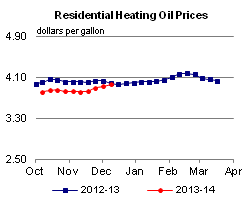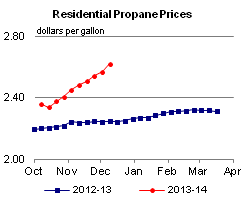Released: December 11, 2013
Next Release: December 18, 2013
Light Louisiana Sweet (LLS) crude oil now sells at a historically large discount to Brent
While West Texas Intermediate (WTI) crude oil has traded at a persistent discount to Dated Brent crude since late 2010, the near-parity between Light Louisiana Sweet (LLS) crude and Dated Brent has only recently changed. In July, as U.S. refiners processed near-record amounts of crude oil, the discount of WTI relative to Brent narrowed to an average of $3.26 for the month, the lowest since December 2010. As the Brent-WTI spread began to widen again in September, the LLS price, which historically had closely tracked Brent, moved lower with WTI. From January through August, LLS prices averaged $1.45 per barrel more than Brent, but since the start of September, LLS prices averaged $7.14 less than Brent. The opening of a large LLS discount to Brent and the increasing convergence of LLS and WTI prices result from pipeline expansions and reversals that have reduced bottlenecks in the U.S. mid-continent, continuing growth in domestic light oil production, and a seasonal decline in crude oil runs at U.S. Gulf Coast refineries during October.
Prior to this autumn, discounted crude oil prices had generally been limited to the U.S. mid-continent, where crude oil production growth had outpaced the capacity of pipeline infrastructure to bring that production to refining centers on the U.S. Gulf Coast (Figure 1). Crude oil inventories at Cushing, Oklahoma, averaged approximately 50 million barrels throughout the first half of this year, but then fell by an unprecedented 17 million barrels over 14 weeks starting in July as pipeline capacity expansions and pipeline reversals alleviated transportation bottlenecks from the mid-continent to the Gulf Coast.
The small average premium of LLS relative to Brent that persisted through August of this year reflected a price structure that enabled importers of light sweet crude oil to cover the cost of waterborne shipment to the LLS pricing point in eastern Louisiana on the U.S. Gulf Coast. However, recent infrastructure changes, coupled with continued growth in U.S. light crude production, have changed the market equation. The reversal of Shell Oil's Houma to Houston (Ho-Ho) pipeline, which traditionally shipped offshore crude oil production (including LLS) from Houma, Louisiana to the Houston area, is one notable example. With growing light sweet production from Texas' Eagle Ford and Permian fields finding its way to Houston and eliminating the need for westward flows on Ho-Ho, Shell decided to reverse the pipeline. In mid-August, Shell ceased westward flows on Ho-Ho to begin final work on the reversal. When westward flows on Ho-Ho stopped, supply of LLS in eastern Louisiana, its pricing point, outpaced demand from local refineries, and prices abruptly flipped from a premium to Brent to a discount. Shell has announced eastward flows on Ho-Ho will commence in early 2014.
The Ho-Ho reversal, additional infrastructure changes, growing domestic production, and a seasonal decline in crude oil runs at U.S. Gulf Coast refineries put downward pressure on crude oil prices on the U.S. Gulf Coast, which requires increasingly fewer crude oil imports to balance the market. The discount of the spot price for LLS, a key Gulf Coast light sweet crude oil grade, to Brent widened from an average of $3 per barrel in September to almost $11 per barrel in November. Likewise, the discount of the spot price for Mars, a medium Gulf Coast crude oil grade, to Dubai, an international crude marker of similar quality, increased from an average of $4 per barrel in September to $13 per barrel in November. The price difference between WTI and LLS, which has averaged $3.12 since August 1, is consistent with the pipeline cost to bring barrels from Cushing to the Gulf Coast.
U.S. crude oil production continues to grow, recently topping 8 million barrels per day for the first time since November 1988. In the December Short-Term Energy Outlook (STEO), the U.S. Energy Information Administration (EIA) expects U.S. crude oil production will average 7.5 million barrels per day (bbl/d) in 2013 and increase to 8.5 million bbl/d in 2014. The growth in U.S. crude oil production will put continued downward pressure on U.S. crude oil prices such as WTI and LLS.
Looking forward, EIA expects the Brent crude oil price to weaken as non-OPEC supply growth exceeds growth in world consumption. The Brent crude oil price is projected to average $108 per barrel in December 2013 and $104 per barrel in 2014. EIA expects that WTI crude oil prices will average $96 per barrel during the fourth quarter of 2013 and $95 per barrel during 2014. The discount of WTI crude oil to Brent crude oil, which averaged $18 per barrel in 2012 and then fell to $3 per barrel in July 2013, averaged $14 per barrel during November. EIA expects the WTI discount to average $12 per barrel during the fourth quarter of 2013 and $9 per barrel during 2014. The price for LLS crude is expected to continue to move in step with the WTI price plus the pipeline tariff.
Gasoline and diesel fuel prices both down less than a penny
The U.S. average retail price of regular gasoline decreased less than one cent to remain at $3.27 per gallon as of December 9, 2013, eight cents lower than last year at this time. Prices increased one cent in the Midwest to $3.13 per gallon and less than one cent on the West Coast to remain at $3.48 per gallon. The largest decrease came in the Rocky Mountain region, where the price fell four cents to $3.08 per gallon. On the Gulf Coast the price was $3.10 per gallon, two cents lower than last week, and on the East Coast the price dropped a penny to $3.38 per gallon.
The national average diesel fuel price decreased less than one cent to remain at $3.88 per gallon, 11 cents lower than last year at this time. Prices increased less than one cent on the East Coast to remain at $3.91 per gallon, while decreasing one cent in all other regions of the nation. Prices were $3.87 per gallon, $3.77 per gallon, $3.85 per gallon, and $3.99 per gallon, in the Midwest, Gulf Coast, Rocky Mountains, and West Coast, respectively.
Propane inventories fall
U.S. propane stocks fell by 1.7 million barrels to end at 52.6 million barrels last week, 18.6 million barrels (26.1%) lower than a year ago. Midwest regional inventories dropped by 1.5 million barrels, and East Coast inventories decreased by 0.2 million barrels. Rocky Mountain/West Coast inventories decreased by 0.1 million barrels, while Gulf Coast inventories increased by 0.1 million barrels. Propylene non-fuel-use inventories represented 5.8% of total propane inventories.
Residential heating fuel prices increase
Residential heating oil prices increased almost 4 cents per gallon last week during the period ending December 9, 2013 to nearly $3.96 per gallon. This is almost 3 cents per gallon lower than last year's price at this time. Wholesale heating oil prices decreased nearly 2 cents per gallon last week to $3.14 per gallon.
The average residential propane price increased by almost 6 cents per gallon last week to $2.62 per gallon, 37 cents per gallon higher than the same period last year. Wholesale propane prices increased nearly 12 cents per gallon to $1.52 per gallon as of December 9, 2013.
Text from the previous editions of This Week In Petroleum is accessible through a link at the top right-hand corner of this page.
 |
 |
||||||
 |
 |
||||||
| Retail Data | Change From Last | Retail Data | Change From Last | ||||
| 12/09/13 | Week | Year | 12/09/13 | Week | Year | ||
| Gasoline | 3.269 | Heating Oil | 3.956 | ||||
| Diesel Fuel | 3.879 | Propane | 2.621 | ||||
 |
 |
||||||||||||||||||||||||||
|
 |
||||||||||||||||||||||||||
| *Note: Crude Oil Price in Dollars per Barrel. | |||||||||||||||||||||||||||
 |
 |
||||||
 |
 |
||||||
| Stocks Data | Change From Last | Stocks Data | Change From Last | ||||
| 12/06/13 | Week | Year | 12/06/13 | Week | Year | ||
| Crude Oil | 375.2 | Distillate | 118.1 | ||||
| Gasoline | 219.1 | Propane | 52.617 | ||||
